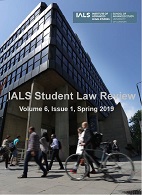Rethinking the Common Intention Constructive Trusts in Stack v Dowden and Jones v Kernott – should the Resulting Trusts be preferred?
DOI:
https://doi.org/10.14296/islr.v6i1.4962Abstract
Yee Ching Leung takes the two landmark cases, Stack v Dowden [2007] UKHL 17 and Jones v Kernott [2011] UKSC 53, as starting points to consider the new Common Intention Constructive Trust approach in dealing with the issue of how the beneficial interest of a property is to be shared between two separating cohabitants. The article analyses whether this new approach should be preferred over the traditional Resulting Trust approach. The author explains the two approaches and gives three arguments in support of the Resulting Trust approach. First, it provides a greater degree of certainty, which is crucial in property law. Secondly, the traditional approach is more coherent in principle when comparing to the Common Intention Constructive Trust approach. Thirdly, the author argues that the Resulting Trust approach would not leave the discretion of judges unconfined. Toward the end of the article, the author gives two brief replies to the critics of the Resulting Trust approach. However, the Common Intention Constructive Trust approach is now the law of England and whether the Resulting Trust approach will return remains to be seen.Downloads
Downloads
Issue
Section
License
Work published in the IALS Student Law Review is licensed under a Creative Commons Attribution-NonCommercial-NoDerivs 3.0 Unported License.
Those who contribute items to IALS Student Law Review retain author copyright in their work but are asked to grant two licences. One is a licence to the Institute of Advanced Legal Studies, School of Advanced Study of the University of London, enabling us to reproduce the item in digital form, so that it can be made available for access online in the open journal system and repository and website. The terms of the licence which you are asked to grant to the University for this purpose are as follows:
'I grant to the University of London the irrevocable, non-exclusive royalty-free right to reproduce, distribute, display, and perform this work in any format including electronic formats throughout the world for educational, research, and scientific non-profit uses during the full term of copyright including renewals and extensions'
The other licence is for the benefit of those who wish to make use of items published online in IALS Student Law Review and stored in the e-repository. For this purpose we use a Creative Commons licence allowing others to download your works and share them with others as long as they mention you and link back to your entry in IALS Student Law Review and/or SAS-SPACE, but they can't change them in any way or use them commercially.



